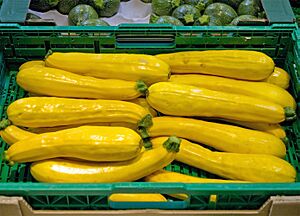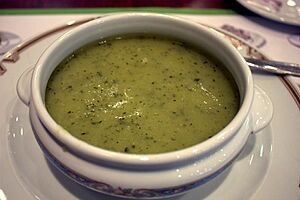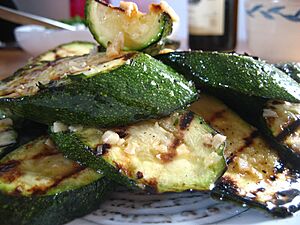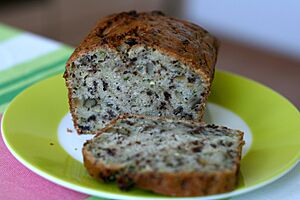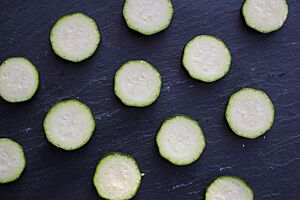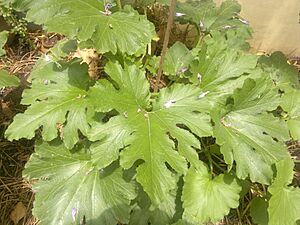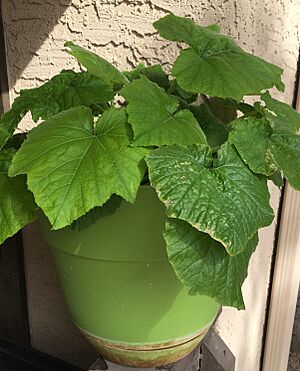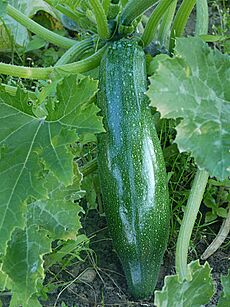Zucchini facts for kids
Quick facts for kids Zucchini |
|
|---|---|
|
Striped and uniform-colored zucchini
|
|
| Genus | Cucurbita |
| Species | Cucurbita pepo |
| Origin | 19th-century northern Italy |
The zucchini is a popular summer squash. It's also known as courgette or baby marrow. This plant grows like a vine, and we eat its fruit when it's young. At this stage, the seeds and skin are still soft and easy to eat.
Most zucchini are green, but you can also find golden ones that are bright yellow or orange. While they can grow very long, up to about 1 meter (3 feet), they are usually picked when they are 15–25 centimeters (6–10 inches) long.
Even though we treat zucchini as a vegetable in cooking, it's actually a fruit! In botany, it's a type of berry. It comes from the swollen part of the zucchini flower.
Zucchini plants first grew in Mesoamerica over 7,000 years ago. However, the specific type of zucchini we know today was developed in Milan, Italy, in the late 1800s.
Contents
What's in a Name?
The zucchini has a few different names in English, and they all mean 'small marrow'.
Zucchini
The name zucchini is used in places like America, Australia, Canada, and New Zealand. It comes from Italian. In Italian, zucchini means 'small gourds'.
Courgette
The name courgette is used in places like Britain, South Africa, and Malaysia. This name comes from French, where courgette also means 'small gourd'.
Baby Marrow
In South Africa, people sometimes use the name baby marrow for zucchini.
Zucchini Flowers
Zucchini plants have two kinds of flowers: female and male. The female flower grows at the end of each zucchini fruit. The male flower grows directly on the plant's stem. Both types of flowers are edible!
Chefs often use these beautiful golden blossoms to decorate meals. You can also cook them. People deep-fry them in a light batter, stuff them, or use them in soups.
A Brief History
Zucchini, like all squashes, originally came from the Americas. People first grew them in Mesoamerica. But the green, cylinder-shaped zucchini we eat today was developed in northern Italy. This happened in the late 1800s. The first time the name zucchini was used in a description was in 1901 in Milan.
Italian immigrants likely brought zucchini to the United States in the early 1900s. It was probably first grown in California.
Cooking with Zucchini
For the best flavor, zucchini are usually picked when they are under 20 centimeters (8 inches) long. At this size, their seeds are still soft. If zucchini grow much larger, their skin can become hard, and their seeds might be tough.
Zucchini is usually cooked. You can steam it, boil it, grill it, or bake it. It's also great in dishes like soufflés or even in sweet recipes. For example, you can grate raw zucchini into a zucchini bread or zucchini cake.
Zucchini has a mild flavor. It tastes great simply cooked with butter or olive oil and herbs. You usually leave the skin on when cooking. Zucchini can also be eaten raw in salads.
Some people use a special tool called a spiralizer to turn zucchini into noodle-like spirals. These are often called 'zoodles' and are a healthy substitute for pasta.
Zucchini Around the World
- In Australia, a popular dish is zucchini slice, which is like a frittata.
- In Bulgaria, zucchini is often fried and served with a dip made from yogurt, garlic, and dill.
- In France, zucchini is a key ingredient in ratatouille, a tasty stew of summer vegetables.
- In Greece, zucchini is often fried or stewed. People also stuff the flowers with cheese or a mix of rice and herbs.
- In Italy, zucchini is served in many ways. The fried flowers, called fiori di zucca, are a special treat.
- In Mexico, the zucchini flower is used in soups or as a filling for quesadillas. The fruit is used in stews and other dishes.
- In Russia and Ukraine, zucchini is often fried with flour or semolina and served with sour cream.
- In Turkey, a popular dish is mücver, which are zucchini pancakes.
Nutrition Facts
| Nutritional value per 100 g (3.5 oz) | |
|---|---|
| Energy | 64 kJ (15 kcal) |
|
2.69 g
|
|
| Sugars | 1.71 |
| Dietary fiber | 1 g |
|
0.36 g
|
|
|
Protein
|
1.14 g
|
| Vitamins | Quantity
%DV†
|
| Vitamin A equiv.
beta-Carotene
|
7%
56 μg
6%
670 μg |
| Thiamine (B1) |
3%
0.035 mg |
| Riboflavin (B2) |
2%
0.024 mg |
| Niacin (B3) |
3%
0.51 mg |
| Pantothenic acid (B5) |
6%
0.288 mg |
| Vitamin B6 |
6%
0.08 mg |
| Folate (B9) |
7%
28 μg |
| Vitamin C |
16%
12.9 mg |
| Vitamin K |
4%
4.2 μg |
| Minerals | Quantity
%DV†
|
| Calcium |
2%
18 mg |
| Iron |
3%
0.37 mg |
| Magnesium |
5%
19 mg |
| Manganese |
8%
0.173 mg |
| Phosphorus |
5%
37 mg |
| Potassium |
9%
264 mg |
| Sodium |
0%
3 mg |
| Zinc |
3%
0.33 mg |
| Other constituents | Quantity |
| Water | 95.2 g |
|
Link to USDA database entry
|
|
| †Percentages estimated using US recommendations for adults. | |
Zucchini is a healthy food! It's low in calories, with about 17 calories per 100 grams (3.5 ounces). It also has good amounts of important nutrients like folate, potassium, and vitamin C.
Important Safety Tip
Sometimes, zucchini can taste very bitter. This bitterness comes from natural substances called cucurbitacins. These are usually found in very low, safe levels in cultivated zucchini. However, if a zucchini tastes extremely bitter, it's best not to eat it. This can happen if the plant was stressed or if it cross-pollinated with wild or ornamental squash plants. Cooking does not remove this bitterness. If you find a very bitter zucchini, it's safest to throw it away.
Growing Zucchini
Zucchini is quite easy to grow in places with mild climates. In fact, home gardeners often find they have a lot of zucchini! The part we eat is the young fruit, but you can also eat the flowers, mature fruit, and even the leaves.
One way to manage a lot of zucchini is to harvest the flowers. These are a special treat and can be expensive in stores.
Zucchini plants need lots of bees for pollination. If there aren't enough bees, the fruit might start to grow but then dry up or rot. You can help by planting flowers nearby to attract bees or even by hand-pollinating the flowers yourself.
There are many different types of zucchini. Some are lighter green or white, like Lebanese summer squash. There are also round varieties, like "Tondo di Piacenza" from Italy or "Ronde de Nice" from France. In America, you might find round yellow and green zucchini called "8-ball" squash.
How to Grow Your Own Zucchini
To grow a zucchini plant, pick a sunny spot that gets at least 6-8 hours of sunlight each day. Make sure the soil drains well and has lots of good nutrients.
- Plant zucchini seeds when the soil is warm enough, around 21°C (70°F).
- Space the seeds about 60-90 centimeters (2-3 feet) apart in rows.
- Plant the seeds about 2.5 centimeters (1 inch) deep and cover them lightly with soil. Water them gently after planting.
- Keep the soil moist, but don't let it get soggy. Water the base of the plant once or twice a week.
- Add a layer of mulch around the plants. This helps keep the soil moist, stops weeds, and controls soil temperature.
- Feed your plants with compost or fertilizer when they start to flower. Do this every 3-4 weeks during the growing season.
- Make sure bees can reach the flowers to help with pollination. You can plant other flowers nearby to attract them.
- Remove any yellow or sick leaves to help the plant breathe and stay healthy.
- Harvest zucchinis when they are 15-20 centimeters (6-8 inches) long. Picking them regularly encourages the plant to grow more fruit!
Popular Zucchini Types
- Bianco di Trieste
- Black Beauty (very dark green)
- Cocozelle (dark green with white stripes, an older type)




